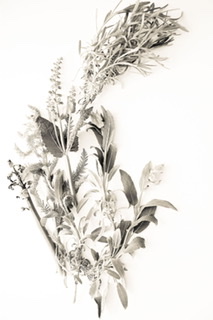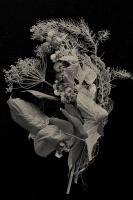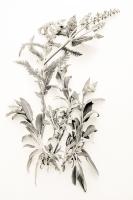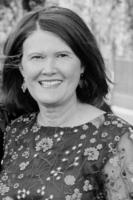Former journalist turned photographer Laura Lloyd creates plant portraits with a historical quality. Using digital tools to alter her photos of native Missouri plants, Laura gives her work warmth and a nostalgic aesthetic. Lloyd’s work is on display at the Gardner branch until August 21, 2022.
*
Introduce yourself and describe your work.
I have spent most of my life living in the Brookside neighborhood of Kansas City, MO, two miles south of the Country Club Plaza. My husband and I raised our three daughters in a frame house with a side porch, a backyard and several trees on the property, where we still live. We became grandparents in 2021. I was an English major at Princeton University, and I worked for many years as a journalist. I discovered photography late in high school and took a class at the Kansas City Art Institute in the mid-1970s, where I learned how to print black-and-white images in a darkroom. Many years later, I familiarized myself with digital photography, a medium that has almost totally supplanted film, for better or for worse. My current work is mostly botanicals, utilizing the native Missouri plants that grow in our yard. I am fascinated by how the “digital darkroom” can impart an old-fashioned look to new images. I am not the only photographer to avail myself of these options: there is a vigorous “neopictorial” movement in contemporary photography that seeks to render warmth, romance and a painterly feeling to works using advanced camera techniques.
You have said you are attracted to a nostalgic or antique aesthetic – tell us more about that.
Since I was a young child, I have been moved by items that seem “old-fashioned”. I am excited by the detail, the quality and the occasional eccentricity of household items from the past. I have a doll whose head is made out of bisque, a watch outlined in small diamonds that belonged to my great-grandmother, picture postcards from the turn of the twentieth century. When I started photographing the plants and flowers in my backyard, I moved them inside and placed them on a uniform dark or light background. My eye immediately saw them as evocations of botanical scrapbooks kept by women in the 19th century. The delicacy of the plants, especially when photographed in a monochromatic palette, didn’t look “modern”. The ability to apply visual effects to the photographs after they were created in the camera allowed me to indulge in a nostalgic esthetic that looks backward to an obvious embrace of the sincerely beautiful.
How has your practice changed over time?
I have gotten past a stage that occupied me for many years, when I tended to make photographs that succeeded in copying the work of other photographers. I might be moved to click my camera when I saw grain elevators that I knew would look like photographs others had taken of grain elevators. I try now to refrain from that. What I photograph may reference other artworks, but I aim to avoid producing work that is simply a poor imitation of some famous photographer’s work.
Who do you consider your main artistic influences?
My visual brain is full of images reflecting a lifetime of going to museums and galleries. I was imprinted with Abstract Expressionism from viewing such work as a child. I have had some success with making abstract photographs. I also love Japanese art, which has allowed me to embrace simplicity. Also, my fascination with household objects from the Victorian age has meant that I always stay open to images that have a little of the “dark” or gothic about them.

What is your most important artistic tool? Is there something you can’t live without in your studio?
Other than my Nikon Z6 full-frame mirrorless camera—which has great abilities to render sharp, highly detailed images—my most important artistic tool is Lightroom, a post-production software program that I much prefer to Photoshop, that allows me to tweak and tinker with my photographs until they have the look I want.
What books, movies and/or music have inspired you recently?
I love Spotify and listen to all kinds of classical music. Baroque harpsichord has been inspiring. I read lots of non-fiction and, as is true of my photography, find the past to be especially fascinating. I just finished a biography of Mary Todd Lincoln after visiting her childhood home in Lexington, KY, where I photographed lots of the ornate, highly detailed furnishings on display.






